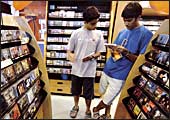|
Being
the CEO of a large pharma company has been a rather depressing
job for more than a year now. As a host of other sectors hitched
a ride on the Sensex's spectacular ride from 5,200 to 7,800 now,
the over $6-billion (over Rs 26,000-crore) pharmaceuticals industry
sat by the sidelines, bogged down by a remarkable number of negative
factors. The change in patent regime, introduction of vat, lacklustre
growth in the domestic market, rising R&D and marketing expenses
on the back of fierce generics market in the us...never in recent
times have drug makers been besieged by such a variety of bad
news. (The shocking highlight was, of course, Dr Reddy's Labs'
first-ever quarterly drop in topline.)
Now, though, things are beginning to look
up due to what is being described by some on Dalal Street as the
"anniversary effect". Meaning that after a year where
so many things went wrong, there's little that can make things
worse for the industry. Actually, that's a rather uncharitable
explanation of why investors are once again flocking to Big Pharma
stocks. At least since the beginning of last year, it was known
that the pressure on generics drugs would be high, given that
there weren't enough branded drugs going off patent. What caught
both investors and drug makers by surprise, however, was the intensity
of price competition. In the case of generics like ciprofloxacin,
the launch price was at a steep 95 per cent discount to the innovator
drug. Says Dilip Shanghvi, Chairman & Managing Director of
Sun Pharmaceuticals: "us generic markets have seen quick
and ruthless price erosion, and sometimes the projections that
people shared did not anticipate what could happen and factored
in all the possibilities as certainties."
Nobody's yet saying that things are hunky-dory in the us (or that
the domestic market, growing at 5-odd per cent, will suddenly
rev up), but what's helping turn the sentiment positive is the
long list of branded drugs that are set to come off patent protection
between 2006 and 2008. Says Malvinder Singh, President, Ranbaxy
Laboratories: "There is tremendous opportunity in generics,
every government is encouraging generics because of significant
increase in healthcare costs." If you are looking for a number,
$30-40 billion (Rs 1,32,000-1,76,000 crore) worth of branded drugs
will open up to generic competition by 2008. Says Giridhar Iyengar,
pharma analyst, ABN Amro: "While pricing pressure will remain,
the new launches will help take pressure off some of the older
products." The net effect could be that earnings on the whole
improve.
As more and more companies-both in India
and elsewhere, especially China-move into the generics space,
the competition will only get tougher. The good news for large
Indian players such as Ranbaxy, Dr Reddy's, Cipla and Sun is that
they are vertically integrated: they make their own bulk drugs,
can manufacture formulations and have R&D capabilities that
allow them to come up with more value-added generic copies. That's
not something other generic players in the US, like Ivax (now
acquired by Israel's Teva Pharmaceuticals) or Novartis' generic
arm Sandoz can claim.
So what's likely to happen in the near future
is addition of capacities in India by both Indian and foreign
drug makers, and a play for acquiring either FDA-certified facilities
of Indian companies, or the companies themselves. Recently, there
were reports that Sandoz was in talks with Cipla. While the Indian
company vehemently denied the reports, its principal owner and
Chairman Yusuf Hamied isn't ruling out any of his options. When
contacted by BT during his recent trip to Pune, Hamied called
talks of a sell-out "rubbish", but added, "What
I am telling you is as of today. Who knows what will happen two
months, six months or a year from now?" Cipla, where there
is no apparent heir to Hamied, had stunned the global drug industry
a few years ago by launching anti-retro virals (ARVs), or aids
drugs, at rock-bottom prices. Such capabilities are of high value
to global generic giants. Says G.V. Prasad, Executive Vice Chairman
& CEO, Dr Reddy's Labs: "Not just generic majors, but
even the next level of (innovator) companies in the us will look
for acquisitions in India."
The bottom line: Like in other Indian industries,
pretty soon there will be clear winners and losers in pharma.
-E. Kumar Sharma
AUTO
Total Recall
Like
in the US, car recalls are becoming pretty standard in India.
Yet, over the last eight years, there have been only four major
recalls.
 MARUTI
800, MARUTI
800,
May 1997
India's first passenger car recall, 50,000 of the iconic
small car were called in for repairs to a faulty pinion in the
steering system.
 HONDA
CITY, HONDA
CITY,
June 2004
A faulty front dampner forced the Japanese car major to recall
13,000 of its cab-forward City.
 HONDA
ACCORD, HONDA
ACCORD,
August 2004
Bravely enough, Honda made a second recall in just two months,
due to (among others) a problematic fuel filler cap in the top-end
Accord.
 MARUTI
ZEN, MARUTI
ZEN,
august 2005
The latest recall, 500 of the B-segment Zen are being called back
to workshops to fix a faulty radiator.
-Kushan Mitra
SECOND
That BPO Security Thing Again
There's no let up in foreign media's sting
operations aimed at Indian BPOs, but such "exposés" are now beginning
to look too formulaic.
 |
| Data security: As safe
in India as elsewhere |
Wannabe
investigative journalists around the world have a new hunting
ground. No, it's not Iraq or Africa, but India. The formula for
instant journalistic fame has become fairly straightforward: Grab
a camera, buy a plane ticket to Gurgaon, Pune or Bangalore, and
go around waving a wad of dollars until you find a BPO employee
who can at least promise to get you confidential data on American,
European or Australian customers. Your scoop, like most recently
Australian Broadcasting Corporation's, is ready. The Kerry Packer-owned
ABC claimed in its Four Corner programme that its undercover reporter
had been offered confidential information on 1,000 Australians
by an Indian call centre employee in Gurgaon, and the data included,
among others, medicare records and passport details.
It's easy to see why foreign media have turned
such "exposés" of Indian BPOs into a thriving
industry. Offshoring of work to low-cost countries like India
has become a huge issue in developed countries such as the US,
the UK, Germany and Australia. Every day, thousands of jobs are
getting shipped out to India and that, understandably, is upsetting
people who are losing those jobs. Therefore, there's a large audience
for stories that profess to drive home the perils of offshoring.
The channels get their TRPs, the tabloids their rare surge on
the news-stands and the audience, more ammunition with which to
trash free market dynamics.
We are not for a moment suggesting that BPOs
in India are foolproof or that breach of data security should
not be taken seriously. On the contrary, customer data are vulnerable
and thefts do take place once in a while. But to portray, and
then repeatedly reinforce, Indian call centres as being more vulnerable
than other BPOs around the world is unfair and an exaggeration.
Says Sunil Mehta, Vice President, NASSCOM, the IT and ITEs industry
association: "The standards of security and data protection
at Indian BPOs are comparable to global standards, if not higher."
Besides, technology is equally vulnerable,
be it Gurgaon or Georgia. Consider this: In February this year,
ChoicePoint, a provider of identification and credential data,
reported theft of data on 145,000 us citizens. In April, HSBC
North America asked 180,000 owners of its General Motors co-branded
(Master) cards to replace their plastic because transaction data
had been compromised.
Ironically, though, industry honchos only
expect such exposés to help the Indian BPO industry in
the long run. How? Customer anxiety, they say, will keep their
own operations on high alert and lead to improvements in their
security systems. Says Pramod Bhasin, President & CEO, Gecis
Global: "We already have very senior level people responsible
for data security and privacy, and integrity and information policies
are constantly communicated to employees." That means no
cellphones, floppy disks, or even blank sheets of paper (they
must be shredded end of work day) are allowed on the shop floor.
Says the CEO of one large BPO in Bangalore: "No matter what,
globalisation of services is an economic phenomenon and here to
stay." Customers elsewhere in the world needn't worry too
much over theft of personal data. BPOs in India will protect them
zealously. We don't say it out of misplaced patriotism, but simple
business logic.
-Supriya Shrinate
The
Ads Are Back
It's pouring ads this season.
 |
| Boom time: HLL splurged on media like
this Surf Excel ad |
India
Inc. is feeling great and it's letting you know that. Advertising
spend, which according to tam Media Research grew 13 per cent
last year to Rs 11,800 crore, could surge 20 per cent this year.
Sources suggest that around Rs 7,200 crore has already been spent
on advertising and marketing in the first half of 2005. "There
has been a 20 per cent to 50 per cent increase in spends across
the board," says an industry analyst. Who's fuelling the
ad boom? The on-the-mend FMCG biggies such as HLL, P&G, Colgate,
Gillette and GlaxoSmithKline Consumer (see The Big Spenders),
"besides which there has been an increased media demand from
new categories like retail, education, financial services, public
sector and it", says Sam Balsara, the outgoing President
of the Advertising Agencies Association of India. Traditional
high rollers such as white goods, automotive and telecom, notes
Balsara, have anyway kept up their "tempo".
A surprise spender, however, has been the
government. According to industry estimates, the government has
already spent Rs 100 crore so far this year, and could double
the figure in the second half. Says Devraj Tripathy, General Manager,
Maxus, a Group M media buying agency: "The consumer affairs
and tourism ministries have already awarded Rs 50-70 crore media
duties to various (ad) agencies and by the year-end, the government
could end up spending Rs 350-400 crore." That's just a little
(Rs 50-100 crore) less than how much HLL, the top spender, is
expected to splurge on media this year. Says Sandip Tarkas, CEO,
Media Direction: "The (government's) thrust on communication
this year is indicative of the economy's pink health." In
other words, they are lovin' it.
-Archna Shukla
KBC
2
Newer,
But Better?
 |
 |
| Old vs new: His charm remains
undiminished |
It's
not quite, like its new punchline says, Umeed Se Dugna (roughly,
double the expectation), but Kaun Banega Crorepati (KBC) Ver.
2.0 is actually pulling in more eyeballs. The opening day channel
share of Star Plus, which airs the game show, had moved up almost
24 per cent in the prime time, 9-10 p.m. time band, when the KBC
was first launched in 2000. But a huge build-up to KBC 2 by Star
has taken that figure to 28 per cent. Does it mean that sceptics
(there are many across rival channels, media buyers and advertisers)
have been proved wrong? Well, yes and no. While the opening day
figures do point to a huge pent-up demand for the Who Wants To
Be A Millionaire? clone (between 2000 and 2005, over 25 million
cable & satellite homes have been added), the proof of the
pudding (and of show host Amitabh Bachchan's charisma) will be
in sustaining the TRPs. "In 2000, KBC ratings remained high
and steady for more than eight weeks before registering a dip,"
says Sandip Tarkas, CEO of Media Direction, a media buying house.
"We have to wait and watch the trend with KBC 2." The
international show's second and third runs have tended to lose
viewers (by as much as half, sometimes). Will the desi version
prove far more durable? We'll have to wait to find out.
-Shailesh Dobhal
Singing
The Blues
Squeezed, music industry seeks new ways to
survive.
 |
| Out of tune: Ringtones and MP3 music
may bring the industry in sync |
What
does an industry do when its revenue more than halves in just
five years? First, it thinks of survival, and then growth. That's
exactly the state of mind in the Indian music industry, which
today is running out of ideas and customers. The industry's revenue
is down from Rs 1,000 crore in 2000 to Rs 500 crore and, predictably,
only those with deep pockets have managed to survive the squeeze.
"It is time to accept the reality that the physical format
of selling has taken a beating," says Kulmeet Makkar, Chief
Executive, Saregama Music. He thinks the "profit-sharing"
model with producers that his company has adopted is the way forward.
This ensures that the music companies stick to marketing and distribution,
and don't get into risky manufacturing. "We adopted this
model for Murder and it paid off," he says. A far cry from
the days when the music of K3G was sold for Rs 11 crore and that
of Devdas, Rs 13 crore.
With the onslaught of technology in the form
of music on the web and mp3 gaining ground, the music industry
has lost a huge chunk of revenues. Says Gurmeet Singh, Business
Head (Music), Music Today: "There are more people sharing
the pie now. Ringtones is a case in point." According to
Kumar Taurani, Head of Tips Music, the way forward will be to
adopt a downloading model on the lines of iTunes from Apple. "While
that is a good model, it will take two to three years before anything
emerges," he feels. His company, too, has been through a
rough phase. It paid a whopping Rs 8 crore four years ago to buy
the music rights to Subhash Ghai's Yaadein, but is said to have
lost close to 80 per cent on the investment.
Mass music (film music) is what sells largely
in India, and this accounts for two-thirds of the market. Here
again the numbers have dropped to just a million units for a big
hit like Koi Mil Gaya and that conveys the story. According to
Makkar, the future will be about getting in new revenue streams
like ringtones on mobiles. Agrees Shridhar Subramaniam, Sony BMG
Music India's Managing Director, pointing out that public performances
and mobile phones will be where the industry's money will come
from tomorrow.
-Krishna Gopalan
ONEUPMANSHIP
Seen A Coke Ad Lately?
 |
 |
| Cola ad wars: Coke 0, Pepsi 1 |
First, it withdrew
from news channels, then from cricket and this season, it's nowhere
to be seen. We are talking about Coke. To be sure, the cola major
did make an appearance on the telly with Aamir Khan's new makeover
as Mannu Bhabhi, but it was too brief to make a splash. In contrast,
its arch-rival Pepsi has been extraordinarily "bubbly",
spending an estimated Rs 50 crore this season (compared to Coke's
Rs 20 crore). Why is Coke lying low? It's due to a shift in strategy
from mainline to below-the-line marketing, says a spokesperson,
but adds that "our market share has remained intact at 61
per cent". Coke's parent, however, is more forthright in
accepting that it is facing problems in India. In its quarterly
SEC filing, it admits to a drop in sales "due to the impact
of price increases to cover rising raw material and distribution
costs along with the lingering effects of pesticide allegations
in 2004". Back home, Coke is unlikely to release new ads
for the rest of the year. Unless, of course, the new President
Atul Singh decides otherwise.
-Aarchna Shukla
Dissecting
Mumbai's Movie-goer
Shringar Cinemas recently commissioned Mindshare
to survey the movie-going audience in Mumbai. The survey threw
up six types of the movie buff, vastly different from each other.
 |
| It's showtime, folks: Movie-goers at
a theatre in Mumbai. Can you spot the types? |
Groucho
32% of the Mumbai audience
»
Watches movie in a theatre once in three months
» Prefers
Hindi thrillers, but also watches regional flicks
» Usually
turns up 15 minutes late for the screening
» Watches
the movie with spouse/children
» Belongs
to SEC A1+/A2, is predominantly male between 25 and 44
Middle-class Housewife
9% of the Mumbai audience
»
Watches movie in a theatre once in four to six
months
» Prefers
Hindi horror or social drama movies
» Arrives
10 minutes before the movie starts
» Watches
movie either alone or with friends/spouse/children
» Belongs
to SEC B1/B2, is predominantly female between 25 and 34/44 and
55
Geek
27% of the Mumbai audience
»
Watches movie in a theatre once a month
» Prefers
Hindi action or war movies, but also watches dubbed English flicks
» Gets
in five minutes before the movie starts
» Watches
movie mainly alone or with friends
» Belongs
to SEC A, and is in the age group of 15 to 24
Barbie Doll
8% of the Mumbai audience
»
Watches movie in a theatre once in two weeks
» Prefers
latest blockbusters, action, children's & animation films
» Usually
enters at the time the movie starts
» Watches
movie mainly with parents
» Belongs
to SEC A1 and SEC C, and is predominantly female between 15 and
19
Western
15% of the Mumbai audience
»
Watches movie in a theatre at least once a week
» Prefers
watching English action or comedy movies
» Usually
enters the hall 10 minutes late
» Watches
movie mainly with children and family
» Belongs
to SEC A, is predominantly female between 35 and 55
Young Turk
9% of the Mumbai audience
»
Watches movie in a theatre once a week
» Prefers
English movies
» Gets
in 10 minutes before the movie starts
» Watches
movie mainly with friends
» Belongs
to SEC A1+, and is between 20 and 24
|





 MARUTI
800,
MARUTI
800,  HONDA
CITY,
HONDA
CITY,  HONDA
ACCORD,
HONDA
ACCORD,  MARUTI
ZEN,
MARUTI
ZEN, 






